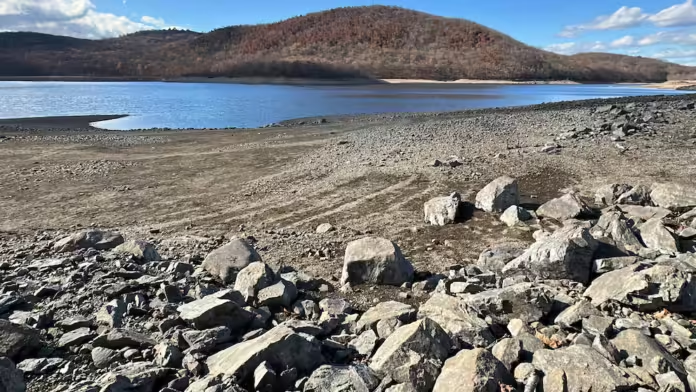A prolonged period of record dryness is gripping the northeastern United States, prompting experts to call for urgent changes in water management and conservation practices. The region, which includes states like New York, Massachusetts, and Pennsylvania, has experienced significantly below-average precipitation over the past year, leading to declining water levels in reservoirs, rivers, and aquifers. This trend, if unaddressed, could have profound implications for agriculture, public health, and ecosystems.
The Scope of the Problem
According to the National Oceanic and Atmospheric Administration (NOAA), much of the Northeast has experienced precipitation deficits ranging from 25% to 50% below normal levels over the past 12 months. This has resulted in some areas being classified under severe to extreme drought conditions. Rivers such as the Connecticut and Delaware have seen reduced flows, while major reservoirs like the Quabbin in Massachusetts are operating below capacity.
Municipal water systems in cities like Boston and Philadelphia have issued advisories urging residents to conserve water. Meanwhile, rural communities reliant on private wells are facing the threat of wells running dry, leading to increased reliance on emergency water deliveries.
Impact on Agriculture and Ecosystems
The agricultural sector has been among the hardest hit by the prolonged dryness. Farmers across the region report reduced yields for staple crops like corn, soybeans, and apples. Irrigation systems, which are not as widespread in the typically water-abundant Northeast, are struggling to meet demand, exacerbating the problem. Livestock farmers also face challenges as pastureland becomes less productive, increasing feed costs.
Natural ecosystems are feeling the strain as well. Aquatic habitats are being degraded due to lower streamflows, affecting fish populations and other wildlife. Forests are more vulnerable to pests and diseases, while the risk of wildfires, though historically low in the Northeast, has increased significantly.
Call for Behavioral and Policy Changes
Experts argue that the current situation should serve as a wake-up call for rethinking how water resources are managed in the region. Here are some recommended actions:
- Enhanced Water Conservation: Public education campaigns should encourage residents to adopt water-saving practices, such as fixing leaks, installing water-efficient appliances, and limiting outdoor water use.
- Improved Infrastructure: Investment in modernizing water distribution systems could reduce losses from leaks, which currently account for up to 20% of municipal water use in some areas.
- Adopting Efficient Agricultural Practices: Farmers can benefit from precision irrigation technologies and drought-resistant crop varieties to optimize water use.
- Regional Cooperation: States should collaborate on water-sharing agreements and joint investments in drought resilience projects, ensuring a coordinated response to shared challenges.
- Policy Changes: Introducing stricter regulations on groundwater extraction and incentivizing rainwater harvesting could help balance supply and demand.
The Role of Climate Change
The prolonged dryness in the Northeast is part of a broader pattern of weather extremes linked to climate change. Warmer temperatures increase evaporation rates, reducing soil moisture and stressing water supplies. While the region has historically been known for its abundant rainfall, scientists warn that climate change could make droughts more frequent and intense in the future.
“What we’re seeing now aligns with projections of how climate change would impact precipitation patterns in the Northeast,” said Dr. Emily Carson, a hydrologist at the University of Vermont. “These changes underscore the importance of adapting our water management practices to new realities.”
Community-Led Solutions
Across the region, communities are stepping up to address the crisis. Local governments are partnering with environmental groups to restore wetlands, which act as natural sponges, retaining water during dry periods. Grassroots organizations are advocating for the preservation of green spaces to enhance groundwater recharge.
In New York’s Hudson Valley, a pilot program is providing grants to homeowners for installing rain barrels and planting native vegetation, both of which help conserve water. Meanwhile, Massachusetts has launched a state-wide initiative to monitor private wells and provide resources to residents affected by water shortages.
Preparing for the Future
While addressing the current drought is critical, experts emphasize the need for long-term strategies to build resilience against future water scarcity. This includes:
- Expanding Water Storage: Constructing new reservoirs and enhancing existing ones to store surplus water during wet years.
- Diversifying Water Sources: Exploring alternatives like desalination and wastewater recycling to reduce dependence on traditional water supplies.
- Investing in Research: Supporting studies to better understand regional hydrology and the impacts of climate change on water resources.
A Wake-Up Call
The record dryness in the Northeast serves as a stark reminder that no region is immune to water scarcity. By adopting sustainable water behaviors and policies now, the region can mitigate the impacts of this crisis and safeguard its water resources for future generations. Whether through individual actions or collective efforts, adapting to the new water realities is essential for ensuring the resilience and prosperity of the Northeast.
